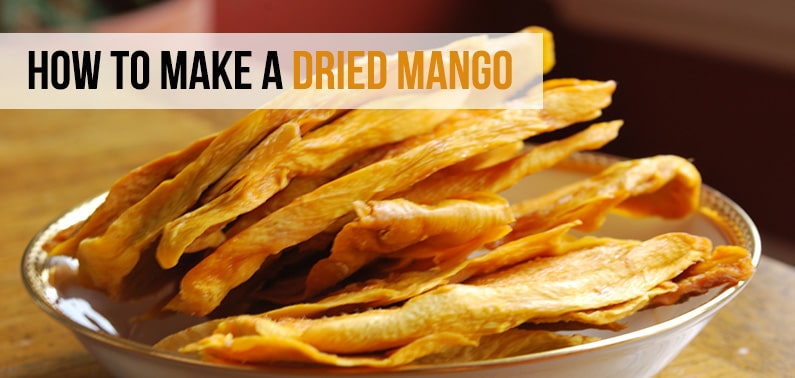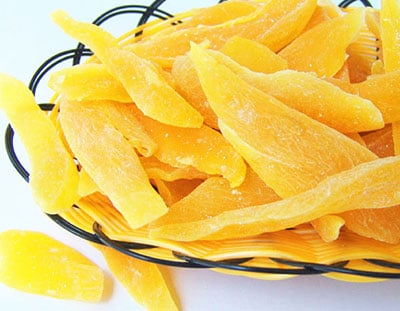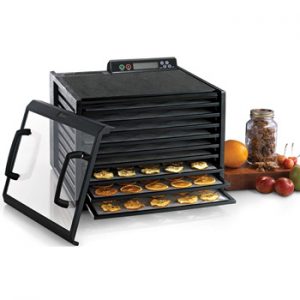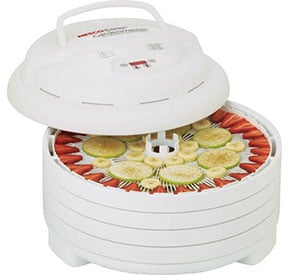
Is there anything better than dried mangoes? They are very sweet, nutritious and make an excellent snack for your whole family, especially for children.
Unfortunately, the ones you bought in the store are usually coated in sugar and have added Sulphur dioxide. But, we have good news for you.
With an inexpensive, good-quality dehydrator you can quickly dry mangoes on your own. It is an excellent source of Vitamin A, which is essential for the immune system, healthy vision, and cell growth. This fruit also contains a small amount of calcium and iron. (source)
Calcium keeps your nerves, muscles, and heart function and helps maintain bone density and strength, while the iron is crucial for oxygen storage in muscle tissue and oxygen transport in the blood. By making this homemade chewy treat, you will save triple on chemicals, calories, and money. We must say that this dried fruit is a fantastic indoor project.
Keep reading to know more about how to make a dried mango so you can enjoy this delicious snack.
1. How to Pick a Good Mango
It gets softer and turns shades of yellow and red as it ripens. But, you need to know that some of them have a natural green or yellow color. And they have this shade no matter if they don’t get ripe or ripe.
So, you shouldn’t judge by its looks; you always need to check how it feels. Choose the one that is soft to the touch but also very firm. If you know how a good avocado feels when you touch it, then you will know to pick the right mango.

2. How to Peel a Mango
Use a knife to cut away an outer peel’s thin layer and do it carefully. Keep the size of each piece equal so that it can dry properly. Until you get to the fibrous core, keep moving around the fruit. And that’s it; you are done with peeling the mango!
3. Drying Process
- For the dehydrating procedure buy in the store between 3 and 45 mangoes. Commensurate the number of the fruits with the amount of the unit trays you have. The next thing is to cut it and prepare them for the process.
- You could also purchase a mango slicer in your kitchen store if you want to cut a large number of them. This way you will reduce a chance of cutting yourself because it is a sticky and hard process.
- Cut about ¼ inch slices before you put it in the dehydrator. Now it is time to place them in your appliance. First, you need to remove the unit’s trays.
- But, make sure that you do this before you cut the mangoes because you want to place them fresh in the device and save its nutrients.
- The pieces need to be arranged properly on the dehydrating trays in parallel lines. Make sure to leave space between the slices so they can dry equally. Set the device to one hundred and thirty to one hundred and thirty-five degrees F and let the mangoes dry for about ten to fourteen hours.
NOTE: It would be best to check them after the first ten hours and make sure that they are dried enough. If not, just keep on dehydrating them. Check them after every hour; this way you will know when to remove them from your appliance.

4. How to Storage the Mango
As it keeps mold and moisture away from the dried food and removes air, the vacuum-sealing will provide the best shelf life. If you are going to dehydrate fruits, then it is a good idea to use the vacuum sealer.
Store containers in the dark, dry and cool area. The best temperature to keep your dried mangoes is about sixty degrees F. It can store up to one year.
If you want to use them over a more extended period, you need to store the fruits in the freezer.
NOTE: Before you eat any dry food, inspect it and throw away anything that has mold.
‘’Fruits with the water removed become dried fruits, lasting much longer than if they were fresh. Since most of the water is removed from the fruit the flavor is intensified, the storage is simplified, and the shelf life is greatly lengthened. The drying process can be done naturally by the sun or in a dehydrator (or less often in a slow oven). Because of its vibrant taste and proven health benefits, like no fat and high fiber, dried fruit is one of the easiest and most popular ways to eat fruit.’’ according to Eat by Date. If you want to know more about nutritional value of dried food read our guide.
Conclusion
Mangoes are a perfect healthy snack for your whole family, packed with essential vitamins and minerals. They are the most popular dried fruit in the market, but be careful with them. Because they are so delicious, you might find yourself eating too much.
Eat an appropriate amount because they have a high concentration of carbohydrates, calories, and sugar. But, it is a delicious and healthy snack that will provide you Vitamin A, C and E, iron, Phenols, Calcium, and Selenium.














Thank you! This is great information – I have 4 large Mango Trees.
This is wonderful this is what am trying to do.